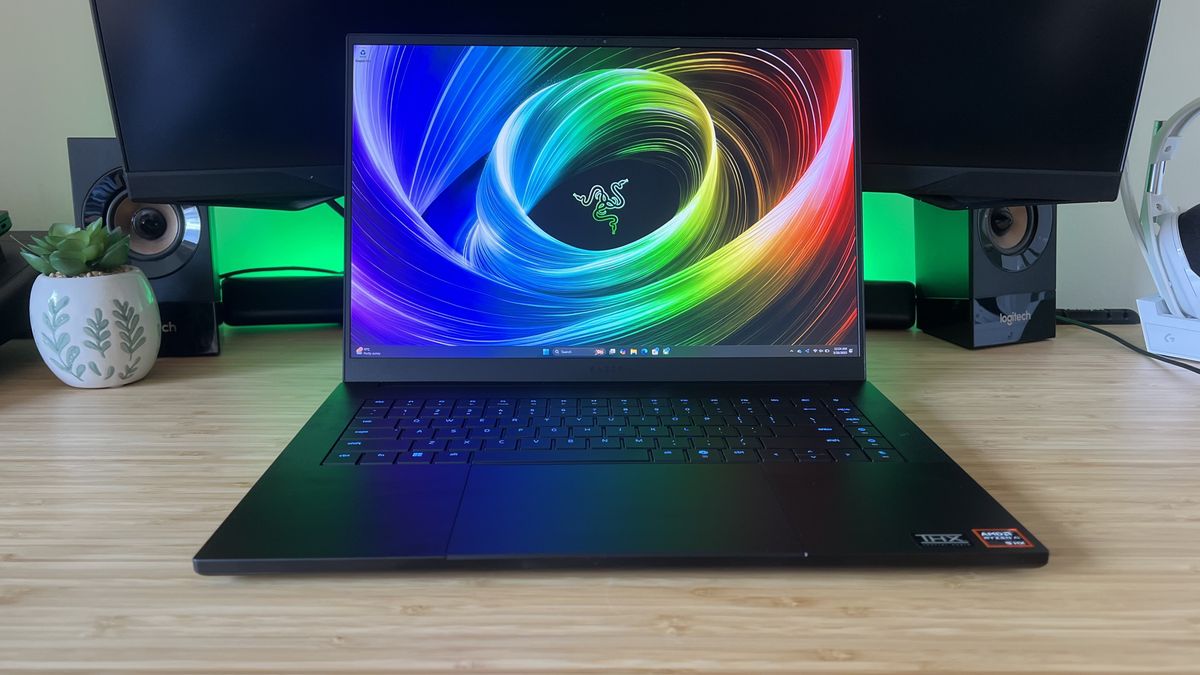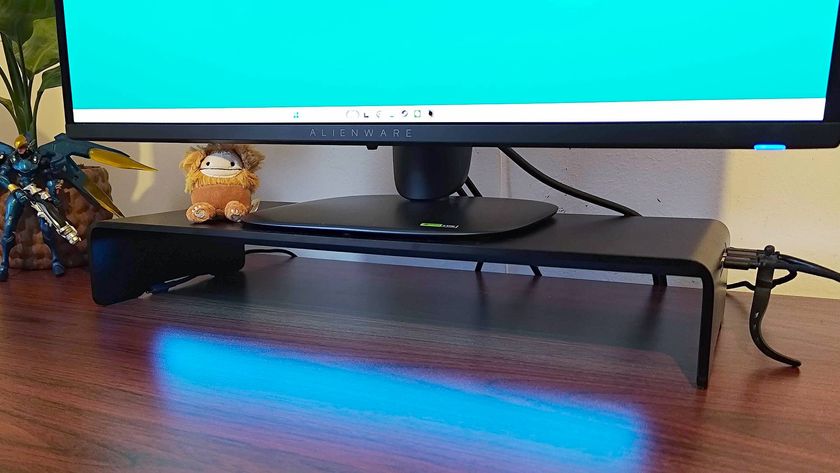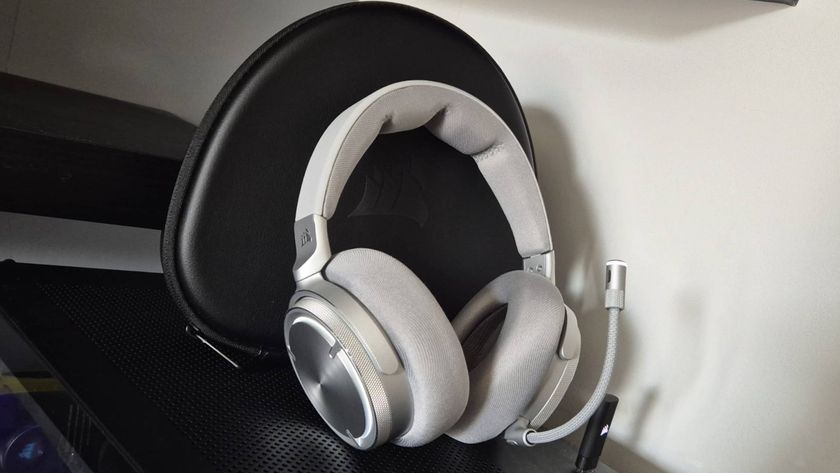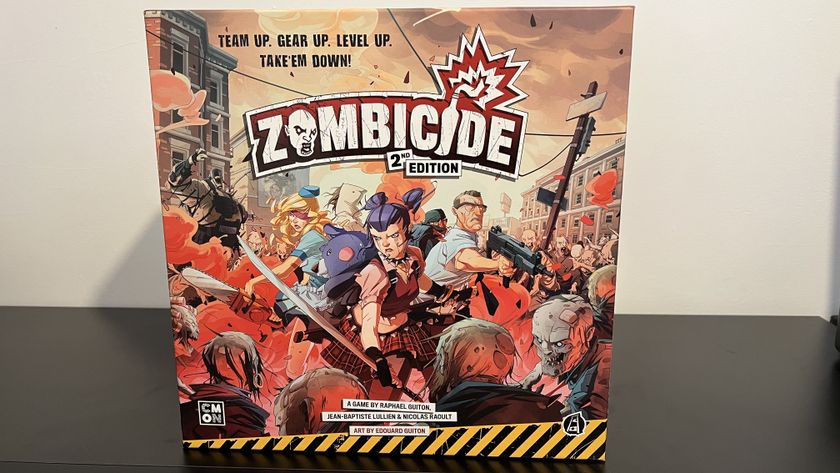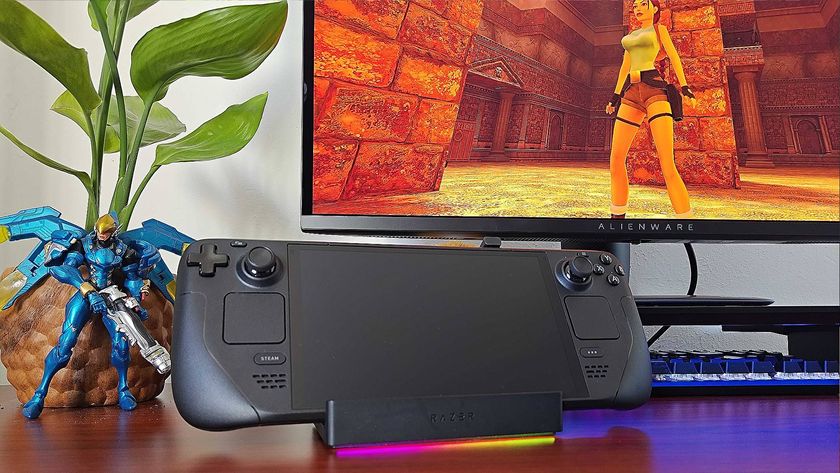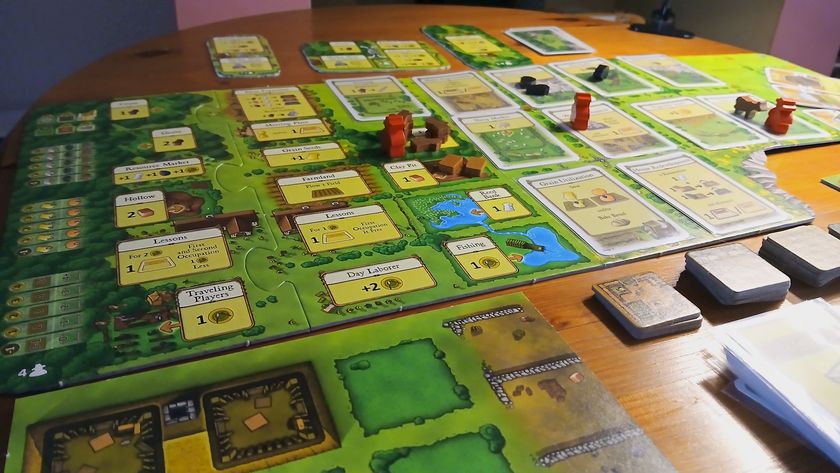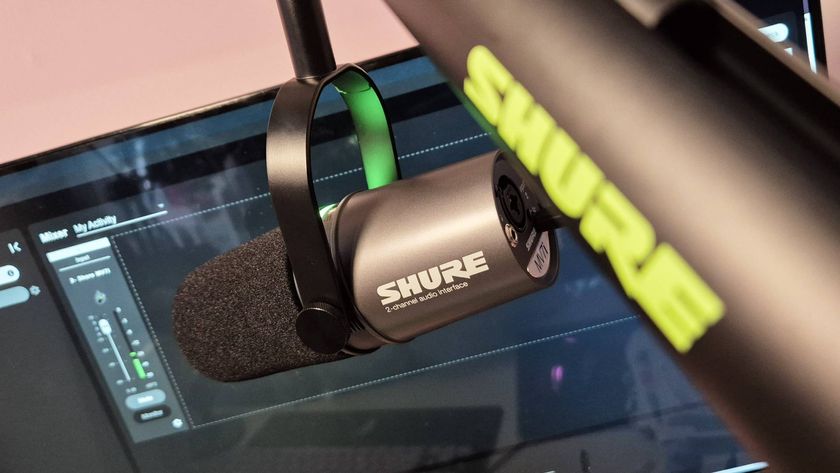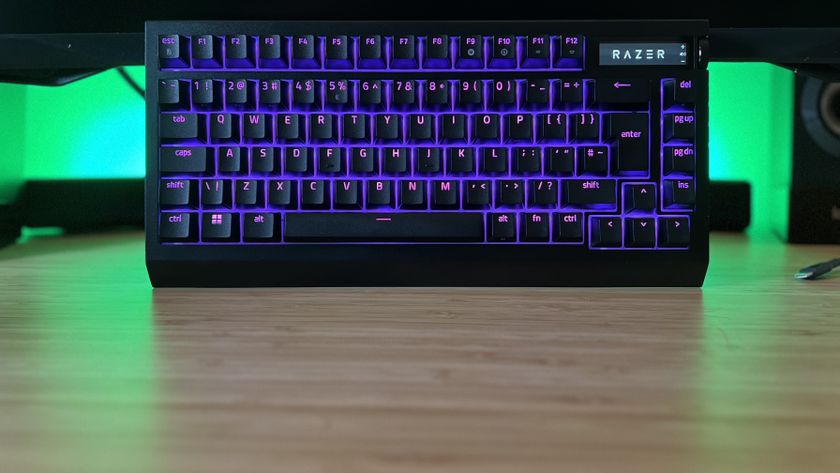12DOVE Verdict
The RTX 5090 isn’t driving the Razer Blade 16 with gen-on-gen performance upgrades, but it is necessary for the machine to realize its true ultra-slim potential. While native performance is disappointing compared to older, and now cheaper, rigs, those looking for a best-in-class chassis experience (and can pay for it) should still get eyes on the new release.
Pros
- +
Best screen I’ve tested yet
- +
Super satisfying keyboard
- +
Ultra-slim design
- +
Still solid performance overall
- +
More focus on portable quality of life
Cons
- -
Native performance shows little improvement
- -
Still tough to play demanding games on battery
Why you can trust 12DOVE
The Razer Blade 16 has been cinched and preened, but it’s not going to offer the kind of power upgrade many were hoping to see from the Nvidia RTX 5090. For the first time, the new generation of mobile GPUs isn’t laying its hat on pure framerate improvements. Instead, things are a little more nuanced than that.
The hardware’s all here, we’ve got a gorgeous OLED display returning for another year, a souped up keyboard that feels better than ever, and a slimline chassis to keep everything particularly portable. Under the hood, though, the AMD Ryzen AI 9 HX 370 isn’t as potent as the Intel i9-14900HX in previous generation models, and the RTX 5090 wants you to think of its benefits in terms of efficiency rather than brute force.
That’s going to be a tough pill for a lot of players to swallow, and it certainly gives the best gaming laptops of the previous generation an extra feather in their caps. This is the first RTX 5090 gaming laptop I’ve tested and, from what I’ve seen so far, this generation feels more like an experiment than the previous. That said, it's an experiment that will benefit gamers looking for a powerful, portable laptop.
Mobile devices may have hit their current power ceiling, so I can see why Nvidia’s had to get creative with ways to improve its experience. Considering the Razer Blade 16 I’ve been testing comes in at a whopping $4,499.99, this is one expensive roll of the dice.
Razer Blade 16 (2025) | Pre-orders from $2,999.99 at Razer
The Razer Blade 16 is currently available to pre-order from Razer direct, ahead of the March 31 release date.
| Row 0 - Cell 0 | Tested | Also Available |
Price | $4,499.99 / £3,899.99 | $2,999.99 - $4,899.99 / £2,699.99 / £4,299.99 |
Display | 16-inch QHD+ OLED at 240Hz | - |
Processor | AMD Ryzen AI 9 HX 370 | AMD Ryzen AI 9 365 |
GPU | Nvidia GeForce RTX 5090 | RTX 5070 Ti | RTX 5080 |
RAM | 32GB | 64GB |
Storage | 2TB SSD | 1TB | 4TB |
Connectivity | WiFi 7, Bluetooth 5.4 | - |
Ports | 3x USB 3.2 Gen 2 Type-A, 2x USB4 Type-C (Power Delivery and DisplayPort 1.4), MicroSD card reader, HDMI 2.1, 3.5mm audio | - |
Dimensions | 0.69 x 13.98 x 9.86 inch | - |
Weight | 2.14kg (4.71lbs) | - |
A super-thin design
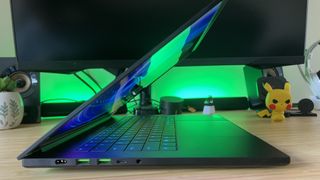
The best Razer laptops have always been particularly skinny. They’re solid black bricks designed to slot neatly into a backpack and withstand transport with a luxuriously durable build. This is that, but on steroids. At just 0.69-inches thick when closed, the 2025 Razer Blade 16 is just a hair thicker than the 2024 Asus ROG Zephyrus G14 - only it’s packing an RTX 5090 under the hood instead of tapping out at an RTX 4070. This is truly the first time I’ve used a gaming laptop designed for high-performance gaming on the go.
That thinner frame makes travelling effortless - it’s still a little heftier than other slimline machines at 2.14kg but it’s still easier on the shoulders than last year’s 2.4kg model. It’s a 16-inch gaming laptop I can pick up and carry with one hand, and that’s not to be taken for granted at this power level.
The main chassis boasts the same CNC-milled construction with a sand-blasted and anodized matte finish for that classic Razer feel. That’s a luxury you don’t find anywhere else - every Razer laptop I’ve tested has shared the same uniquely tactile surface and of course, there’s zero flexing to be found.
A new thermal hood does extend the base of the 2025 Razer Blade 16 a little, but not beyond the lip of the main chassis. This extended bumper adds new ventilation to the system to help keep those powerful components chilled, without adding to the height of the front or rear.
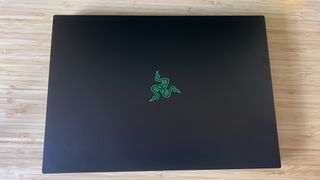
Everything else is as you’d expect it to be. The latest Razer Blade 16 carries a boxy but ultimately subtle aesthetic and that bright green Sneki logo blazes bright in the center of the main lid. There are not garish icons, stamps, or cringey lines of text to deal with - just an understated block of metal hiding some serious power.
Under the hood
Intel is out this generation, with the Razer Blade 16 focusing instead on AMD’s AI-forward processors. The AMD Ryzen AI 9 HX 370 sits inside my testing unit, with 12 cores and 24 threads to its name, and running at a base 3.3GHz, jumping up to 5.1GHz at the top end. That’s the top spec CPU, but you can also configure the 2025 Razer Blade 16 with the slightly weaker AMD AI 9 365, with 10 cores, 12 threads, and a 5GHz max on the clock.
That CPU is our first sign that Razer is going for lean efficiency over raw power with the 2025 Razer Blade 16. It’s simply not as powerful as the Intel i9-14900HX you’ll find inside the fastest gaming laptops on the market, instead focusing its energy on making way for its neural processing to become relevant some day in the near future (it’s not quite there yet, my test system spends very little of its resources on these processes).
It does, however, outperform the Intel Core Ultra 9 185H inside the Asus ROG Zephyrus G16, though time will tell how this matchup plays out when the newer 275HX model hits my testing bench. Interestingly, the cheaper Asus TUF A14 can push that same AMD CPU a little further in PC Mark 10 benchmarks.
Razer’s had to trim its power supply to squeeze everything into that super-thin chassis, with around 155W TGP in the RTX 5090 device. That’s a considerable downgrade compared to the 175W TGP in the RTX 4090 model from last year, and it does make itself known in performance.
The Razer Blade 16 can also be configured with an RTX 5080 or RTX 5070 Ti to bring that final cost down, with either 32GB or 64GB RAM. Razer is shipping the Blade 16 with 1TB, 2TB, or 4TB SSD options.
The numbers
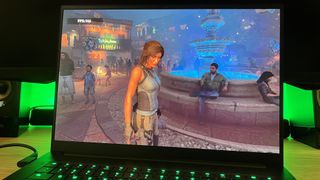
Native framerates in my testing pool rarely bump above 150fps, and unfortunately sometimes don't reach the heights of the RTX 4090 I tested in last year’s release. Materially, we’re down in core frames-per-second across a couple of benchmarks, which I know is going to lift some eyebrows.
Here’s the kicker, though, I don’t know if chasing framerates further into three-figure territory in lighter titles like Shadow of the Tomb Raider is what we need to be doing in the mobile market. This is still a machine capable of running demanding single player games in full resolution super smoothly. It’s disappointing that we don’t see massive benefits from Nvidia’s latest flagship GPU, yes - but that’s not what the Blade 16 is about.
Here are the numbers, all run without DLSS features and the ‘Performance’ power preset. The RTX 5090 inside the Razer Blade 16 2025 lags behind the RTX 4090 in the previous model in both Shadow of the Tomb Raider and Total War: Three Kingdoms; games where native performance means everything without a DLSS helping hand. The machine keeps pace with its predecessor in Returnal.
The 2025 Razer Blade 16 actually fared better in the competition when placed in the QHD+ arena with more demanding games. At the full 1600p, it just about managed to beat the previous generation in Total War: Three Kingdoms and took a much larger lead in Returnal. Shadow of the Tomb Raider still didn’t see any benefits from the newer mobile GPU, though it still stuck close to previous benchmarks.
The RTX 5090 inside the new Razer Blade 16 isn’t a leap in native framerates - at best it just about skirts above the previous generation in a thinner form factor (albeit one with AMD’s AI-focused processor instead of Intel’s i9-14900HX powerhouse). Its pace is still impressive considering its thickness, and it does routinely outperform the super-thin Asus ROG Zephyrus G16 from last year - but the lack of any real push forwards in native speed is going to ruffle some feathers. Of course, I’ve yet to test the GPU inside a larger chassis with a more powerful processor and higher TGP.
Synthetic benchmarks tell a slightly different story. Here, the new RTX 5090 model stands tall over the previous RTX 4090 in easier Fire Strike tests, though does again bump underneath the older release in Time Spy. Considering it beats the much chunkier Lenovo Legion Pro 7i Gen 9 in harder Steel Nomad runs, though, there's still grunt under this hood.
Let's talk DLSS
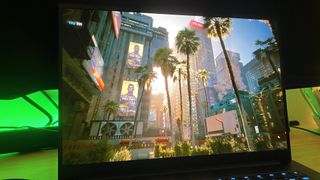
Nvidia’s frame generation features have been divisive in the desktop market, that’s putting it lightly - at its worst, it’s been used to mislead on a marketing level. At times it does feel like a get out of jail free card for the brand, especially considering we’re not seeing much of a native leap between generations.
It can artificially speed up your games without requiring a chunky chassis, a big development for slimline gaming laptops - but it also increases latency slightly and adds some distortion effects. For me in the mobile arena, and as a mostly non-competitive player, though, the tech brings with it a lean approach to making the most out of your games when raw power is always going to be more limited.
Cyberpunk 2077 is a DLSS darling capable of pushing the new transformer tech to its limits and spitting out some sky-high framerates at the end of it.
With the full ray tracing whack, super resolution at ultra performance, and frame generation toggled, the game was running at an average of 249fps in my testing. That did result in some smaller glitchy details, but I only noticed them appearing around neon signs in-game, which sometimes buzzed on and off. With that super resolution set to max out quality, I was still able to play at 148fps. Without frame generation in play, framerates dropped to the low 40s with this picture-buffing feature enabled.
The 2025 Razer Blade 16’s use of the RTX 5090 feels designed to innovate in form factor rather than power. Native QHD+ framerates are still above the 60fps you’d need for a smooth single-player experience, but if you’re chasing revolutionary numbers with every pixel looking as best it can, you’re going to need to get Nvidia’s toys out.
That’s not what everyone wants to hear but, without carting a massive power supply around with you, it’s currently the best way to hit sky-high framerates. Unfortunately, if your games don’t support DLSS features you’re going to be stuck with native performance - and that presents a strong case for sticking with the previous generation and saving cash.
A more useful experience
Instead of focusing on that raw performance, the 2025 Razer Blade 16 and RTX 5090 make a bold move. They concentrate more on efficiency and overall experience. It was that focus that had me running to do something I’m loathe to test in gaming laptops; battery life.
These machines are doing a lot in a small package, so it’s easy to understand why they often tap out at around 45 minutes to an hour of choppy gameplay. The 2025 Razer Blade 16 has shrunk its chassis while also boosting battery life at the same time. While the most demanding games didn’t run well without power attached in my testing, lighter titles like Lost Records: Bloom & Rage and Gears Tactics were chugging away for at least a couple of hours before the laptop died. That’s a considerable increase, even if you’ll still (even with DLSS enabled) need to pick and choose your mobile experiences.
Indiana Jones and The Great Circle is a hungry game and doesn’t quite jump into the ‘playable’ category on battery power, lagging, stuttering, and requiring some serious downgrades in visual quality to run. However, I was able to tap out in Avowed with a zippy, responsive feel - not bad, considering just a few years ago I’d struggle to get more than five minutes into a light turn-based RPG without a freeze-up.
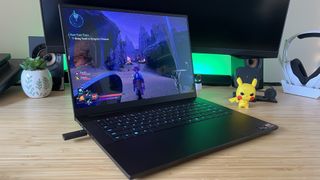
Not only that, but the Blade 16 is also one of the quietest gaming laptops I’ve had whirring away next to me. I’ve grown used to ear-splitting fans over the years - I’ve even heard ringing after powering off particularly offensive cooling systems. Compared to the previous generation, the 2025 Razer Blade 16 is whisper quiet.
That quiet performance, better battery life, and reduced fan noise wouldn’t have been possible without the extra efficiency of the newer mobile GPU. The RTX 5090 is here to round out the laptop experience now that TGP watts are shrinking to make way for more useful laptop experiences. 18-inch chunky behemoths are great for desktop-based play with the option to move around every now and then, but most players buy their gaming laptops for portability - and this feels like the first improvement to quality of life that I’ve seen in a long time.
OLED still reigns supreme
One of my favorite things about the previous-generation Razer Blade 16 was its screen, and the same OLED panel has returned in the 2025 iteration. It’s pretty much the exact same display, but considering it’s still the best screen I’ve used on a gaming laptop to date I’m glad the brand is sticking to its winning formula.
A 16-inch QHD+ panel running at 240Hz could be considered par for the course to the uninitiated, but once you see these colors up close in person it’s obvious that this screen is in a different league. Boasting incredible vibrancy, almost painfully vivid colors and contrast, and exceptional accuracy, the Blade 16 has both gaming and media editing chops.
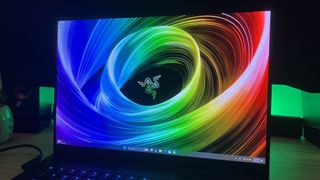
An OLED screen means a contrast ratio advertised at 1M:1, but Razer’s panel also boasts Calman-verified color presets and Nvidia G-Sync built in as well. That’s all great on paper - in real life, it’s breathtaking. The darker scenes of Fallout 4 and Returnal give the OLED’s true-black (and therefore excellent color vibrancy) the best playground, but it was Horizon Zero Dawn: Remastered and Avowed’s rusty orange hues that had me particularly impressed.
The former’s wild landscapes offered a cacophony of colors, all fine-tuned and beautifully saturated to fill the screen with their own characteristics in tandem. Even the slight coloration differences in Meridian’s stone walls were represented with plenty of detail.
While there’s some glare from that shiny surface, brightness was strong enough to keep most encroaching daylight at bay - though its best work was done at night.
A clear-cut win for laptop keyboards
While the benefits of the new GPU are a little more nuanced than we’re used to from the previous generation, the new keyboard is an easy win. Razer has updated its deck with scissor-switches under the hood, offering a larger 1.5mm key travel and 63g of actuation force. They feel fantastic under the fingertips.
Every press offers an incredibly satisfying bounce with just enough tension to feel significant while remaining energetic in both work and play. The keys themselves are well balanced and placed within easy reach of the main palm rests, with a slightly smaller trackpad staying firmly out of the way when typing.
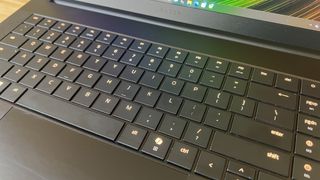
There’s a solid attention to detail on this deck as well, with dual-LEDs under each cap ensuring both main and secondary functions are illuminated brightly and evenly. There are a few new additions here, a Copilot key keeps AI assistance close by, while a new strip of macro keys line the right side of the deck.
That means we’ve not got dedicated clickers for simple functions like page up and down, which is particularly handy during work hours, as well as toggles for the system’s Game Mode and different performance presets, and a mic mute. These can also be configured to different functions within Synapse, running M1 through M5 for personalized macro inputs.
Razer has also upgraded its audio, with four upward and two downward firing speakers, most notably spotted flanking each side of the slightly extended keyboard.
Some teething issues
This is a new device with stability updates to come, but there were a few issues in my testing. General everyday performance seemed to slow right down once or twice during use, with the cursor lagging significantly and longer load times even on lighter apps. That was rare, and will likely be ironed out with updates once the Razer Blade 16 hits mass market shelves.
I managed to completely crash it once, when trying to run Indiana Jones and the Great Circle. And I don’t mean just a straight exit to desktop, I mean fans whirring all the way up before the system fully shut off. Again, this is likely the result of newer drivers needing some additional work after launch, but it was surprising enough in a $4K machine to mention here.
Interestingly, all these issues sprung up only on my final day of testing, I should note that the system has been running fine otherwise - I’ve reached out to Razer with my concerns and will update this review accordingly.
Should you buy the 2025 Razer Blade 16?
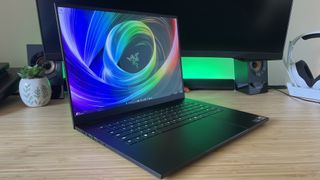
The actual Razer Blade 16 of this new release is blindingly impressive, with its incredible display, super satisfying keyboard, thinner form factor and expansive port selection. The GPU of this release is going to divide the market. It’s not the fix for slimline gaming laptops that I thought it would be - in fact, it’s barely an upgrade over the previous generation in terms of pure native performance.
That said, we do seem to have hit a ceiling in what these mobile cards can do by themselves, and Nvidia’s DLSS additions bring their own unique benefits to the system as a whole. Improved framerates in chunkier games come at the cost of minor visual distractions, but I only noticed a little artifacting and some buzzing every now and then in my testing. If that’s what it takes to get 200+ fps in Cyberpunk 2077 while on the go in 2025, then here we are.
There are a number of compounding factors holding the performance of the Blade 16 back, from the lower TGP to the slimmer form factor to the CPU. Ultimately, this is a machine designed for gamers and creators looking for a better overall experience and have some serious cash to burn on it - the price doesn’t make sense otherwise.
If you’re looking to splash out on a new machine and want the best look, feel, and quality of life features (screen, keyboard, battery life, and form factor) that I’ve tested so far, you’ll be happy with this model. Think of it more as the same as last year’s but with some key external upgrades. If you’re investing in a performance-first device promising true next-generation power, I’d wait and see what chunkier machines with more powerful processors can do with the new generation.
How I tested the Razer Blade 16
I spent just under two weeks with the RTX 5090 Razer Blade 16, using the device for all daily work and play during that time. I tested using both native performance and DLSS features where available, across Shadow of the Tomb Raider, Total War: Three Kingdoms, Returnal, The Talos Principle 2, Cyberpunk 2077, Black Myth Wukong, and Horizon Zero Dawn: Remastered. I also played Indiana Jones and the Great Circle, Avowed, Lost Records: Bloom & Rage, and Gears Tactics both powered and on battery. I completed synthetic benchmarks across 3D Mark’s Time Spy, Fire Strike, and Steel Nomad, as well as PC Mark 10’s CPU test. For more information on how we test gaming laptops, check out our full 12DOVE Hardware Policy.
I'm also hunting down all the best Asus gaming laptops and the best Alienware laptops available now, or check out the best gaming PCs for a more permanent setup.

Managing Editor of Hardware at 12DOVE, I originally landed in hardware at our sister site TechRadar before moving over to GamesRadar. In between, I've written for Tom’s Guide, Wireframe, The Indie Game Website and That Video Game Blog, covering everything from the PS5 launch to the Apple Pencil. Now, i'm focused on Nintendo Switch, gaming laptops (and the keyboards, headsets and mice that come with them), PS5, and trying to find the perfect projector.
You must confirm your public display name before commenting
Please logout and then login again, you will then be prompted to enter your display name.

After struggling to make sequel-sized changes, fans think Blizzard might retire the '2' in Overwatch's name based on Season 16 leaks

Valve leads considered making a "mediocre" game before Half-Life to build the team up, but original marketing exec said "if you do that, the company will fail"

Take-Two won't begin marketing GTA 6 until it's closer to release: "The anticipation for this title may be the greatest anticipation I've ever seen for any entertainment property"
